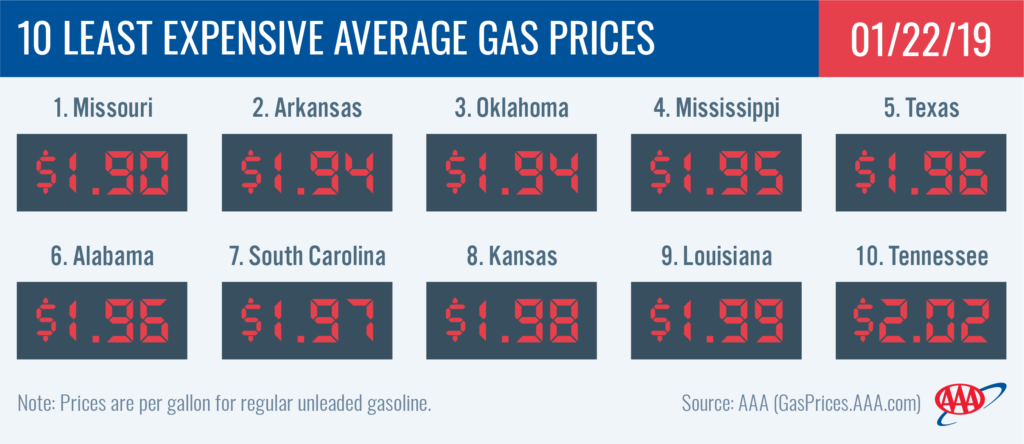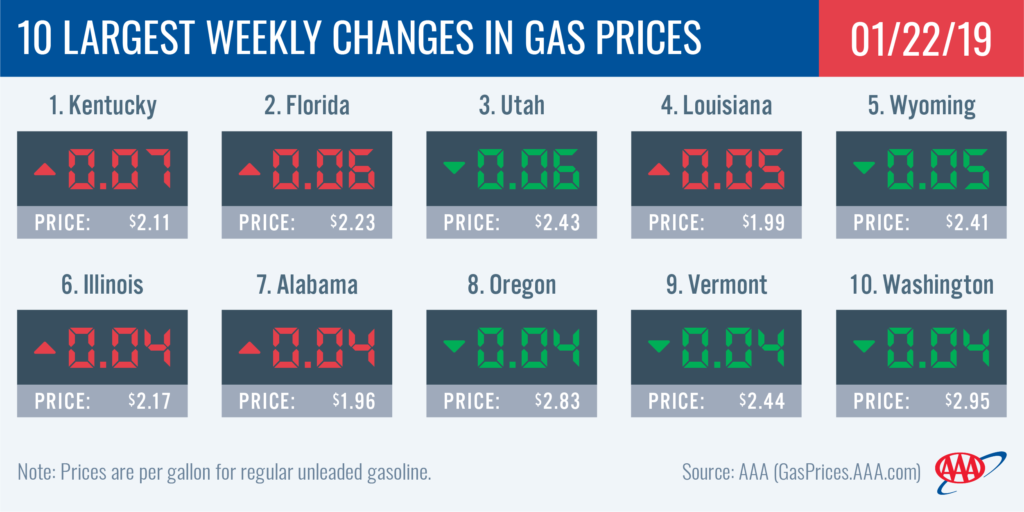The national gas price average may have held flat on the week at $2.25, but just a three cent drop would bring the U.S. average to the lowest since December 2016. However, as crude oil prices continue to climb it does not look like pump prices will drop much lower than we’ve seen so far this year.
“Crude oil prices have increased by $5/bbl since the beginning of the year, but over-supply of crude in the market and low demand have helped to keep the national average relatively stable,” said Jeanette Casselano, AAA spokesperson. “Crude oil prices will be a dominant factor towards determining if motorists will see slightly cheaper or more expensive pump prices in coming weeks.”
On the week, state gas price averages fluctuated with a handful of southern and mid-western states seeing gas prices increase, though the majority of states saw averages decrease or hold flat. Today’s national gas price average is nine cents cheaper than a month ago and 29 cents less expensive than a year ago.
Quick Stats
- The nation’s top 10 largest weekly changes are: Kentucky (+7 cents), Florida (+6 cents), Utah (-6 cents), Louisiana (+5 cents), Wyoming (-5 cents), Illinois (+4 cents), Oregon (-4 cents), Vermont (-4 cents), Washington (-4 cents) and Alabama (+3 cents).
- The nation’s top 10 least expensive markets are: Missouri ($1.90), Arkansas ($1.94), Oklahoma ($1.94), Mississippi ($1.95), Texas ($1.96), Alabama ($1.96), South Carolina ($1.97), Kansas ($1.98), Louisiana ($1.99) and Tennessee ($2.02).
South and Southeast
With the exception of New Mexico (-2 cents), all states in the South and Southeast saw gas price averages increase on the week. Florida (+6 cents) and Louisiana (+5 cents) saw the largest increases of any state in region and the country on the week. All other states averaged a two or three cent increase. Despite the jumps at the pump, the region continues to lay claim to the cheapest gas price averages in the country. A motorist can find gas for $2 or below at 3 in 4 gas stations in every South and Southeast state except New Mexico, Georgia and Florida.
Part of this week’s pump price increase could be attributed to lingering impacts from the 2018 hurricane season causing localized tight gasoline supply and higher transportation costs. Last week, the Federal Motor Carrier Safety Administration extended emergency declarations citing “ongoing emergency conditions” stemming from both Hurricane Florence and Michael for six states, including Alabama, Florida, Georgia and South Carolina.
The Energy Information Administration (EIA) reports that regional gasoline stocks have built week-over-week since the end of November. The latest EIA report says stocks for the South and Southeast measure at their highest level on record at 90 million bbl.
Rockies
For a second week, Utah (-6 cents), Wyoming (-4 cents) and Idaho (-3 cent) appear on the top 10 list of states with the biggest changes. Motorists in the region are seeing a real cost savings – as much as 65-cents – compared to this summer, when the majority of the region was consistently above $3/gal. Today’s averages are all at $2.50 or cheaper: Utah ($2.43), Idaho ($2.43), Wyoming ($2.41), Montana ($2.280) and Colorado ($2.09).
Gasoline stocks in the region decreased by 282,000 bbl, wiping out the bulk of the previous week’s build. Regardless, total stocks sit at a healthy 7.2 million bbl for the region.
Mid-Atlantic and Northeast
Pump prices continue to fluctuate, though modestly, for motorists filling up in the Mid-Atlantic and Northeast region. The majority of states saw gas prices decrease as much as four cents on the week. However, the number of states seeing gas price average increases is growing, up two from the previous week to total six states with increases: Delaware (+3 cents), Tennessee (+2 cents), North Carolina (+2 cents), Virginia (+2 cents), Maryland (+2 cents) and New Jersey (+1 cent).
Gasoline stocks in the region have jumped by a staggering 5 million bbl since the end of December, per EIA data for the week ending January 11. An increase in the winter months is not uncommon, but it’s a vast difference from the same time period last year that only saw a 2 million bbl increase. The surge in stocks, attributed to imports and low demand, combined with a 5 million bbl year-over-year surplus is helping to keep any fluctuation in the region modest.
Great Lakes and Central
Eleven of the top 15 states with the largest year-over-year difference in pump prices are Great Lakes and Central states: Iowa (-48 cents), Michigan (-48 cents), Nebraska (-47 cents), Wisconsin (-46 cents), Illinois (-44 cents), Minnesota (-44 cents) Indiana (+42 cents), Missouri (-41 cents), Kansas (-40 cents), North Dakota (-38 cents) and Ohio (-37 cents).
On the week, states in the region saw prices drop a penny, hold steady or increase. Six states have more expensive gas price averages to start the work week: Kentucky (+7 cents), Illinois (+4 cents), Nebraska (+2 cents), Iowa (+2 cents), Kansas (+1 cent) and Ohio (+1 cent).
With a 3 million bbl build, regional gasoline stocks sit at 60 million bbl. This is a level not seen in 10 months and is uncharacteristically high for this time of the year. With major winter weather pounding much of the region over the weekend and fewer motorists on the road, gasoline demand has the potential to drop, in turn increasing stocks in the next EIA report.
West Coast
Motorists in the West Coast region continue to pay the highest pump prices in the nation, with all of the region’s states landing on the nation’s top 10 most expensive list. California ($3.27) and Hawaii ($3.27) are tied for the most expensive market in the nation, followed by Washington ($2.95), Alaska ($2.92), Nevada ($2.88), Oregon ($2.83) and Arizona ($2.55). While expensive, prices are falling, with all state averages moving lower on the week: Oregon (-4 cents) and Washington (-4 cents) saw the largest drops.
EIA’s recent weekly report showed that West Coast gasoline stocks grew by approximately 800,000 bbl to 31.5 million bbl during the week ending on January 11. However, stocks are approximately 3.2 million bbl lower than at this time last year, which could cause prices to spike if there is a supply challenge in the region this week.
Oil market dynamics
At the close of Friday’s formal trading session on the NYMEX, WTI increased $1.73 to settle at $53.80. Oil prices saw their third consecutive week of increases after the market responded positively to news that the U.S. and China are making progress in resolving their trade dispute. More indicators of economic progress could help buoy crude prices this week; however, increasing fear about slowed global economic growth throughout 2019 could suppress prices as market observers wonder if global crude demand will suffer. Additionally, OPEC released a list of specific production cuts from its members and other members of its global pact to cut global production by 1.2 million b/d for the first 6 months of 2019. The list has helped to bolster market confidence in seeing the global glut of crude decline, which will ultimately help to increase crude prices.
In related news, EIA’s weekly report showed that total domestic crude inventories fell last week by 2.6 million bbl to 437.1 million bbl. However, the current inventory level is 24.4 million bbl more than last year at this time. Domestic crude production also hit a new all-time record high, since EIA began reporting the rate in 1983, at 11.9 million b/d last week. Additionally, Baker Hughes, Inc. reported that last week, the U.S. lost 21 rigs, bringing the total rig count to 852. When compared to last year at this time, there are 105 more rigs this year.
Motorists can find current gas prices along their route with the free AAA Mobile app for iPhone, iPad and Android. The app can also be used to map a route, find discounts, book a hotel and access AAA roadside assistance. Learn more at AAA.com/mobile.


